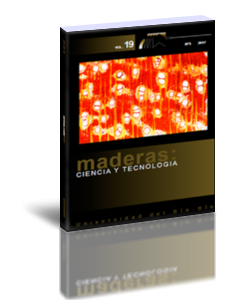Determination of decay resistance against Pleurotus ostreatus and Coniophora puteana fungus of heat-treated scotch pine, oak and beech wood species
Keywords:
Brown rot, Fagus orientalis, heat modification, Pinus sylvestris, Quercus petreae, ThermoWood, white rot.Abstract
The objective of this study, to investigate decay resistance against Pleurotus ostreatus and Coniophora puteana fungus of heat-treated (ThermoWood method) Scotch pine, oak and beech wood species. Scotch pine (Pinus sylvestris), oak (Quercus petreae) and beech (Fagus orientalis) wood species were heat treated at 190°C for 2 h, 212°C for 1 h and 2 h by the ThermoWood® method. Untreated and heat-treated specimens were exposed to white-rot fungus (Pleurotus ostreatus) and brown-rot fungus (Coniophora puteana) for 12 weeks according to procedures defined in JIS K 1571 standard. After weight losses of all specimens were calculated. According to the results, least weight loss was determined on heat treated at 212°C for 2 h. Heat treatment can be used effectively against fungal attack for Scotch pine, oak and beech wood species.Downloads
References
Brischke, C.; Meyer-Veltrup, L. 2016. Performance of thermally modified wood during 14 years of outdoor exposure. International Wood Products Journal 7(2): 89-95.
Brischke, C.; Welzbacher, C.R.; Rapp, A. O.; Augusta, U.; Brandt, K. 2009. Comparative studies on the in-ground and above-ground durability of European oak heartwood (Quercus petraea Liebl. and Quercus robur L.). European Journal of Wood and Wood Products 67(3): 329-338.
Boonstra, M.; Van Acker, J.; Kegel, E.; Stevens, M. 2007. Optimisation of a two-stage heat treatment process: durability aspects. Wood Sci Technol 41(1): 31-57.
Dirol, D.; Guyonnet, R. 1993. Durability by rectification process, In: International Research Group Wood Pre, Section 4-Processes, Nº IRG/WP 93-40015.
Esteves, B.; Marques, A.V.; Domingos, I.; Pereira, H. 2006. Influence of steam heating on the properties of pine (Pinus pinaster) and eucalypt (Eucalyptus globulus) wood. Wood Sci Technol 41:193-207. DOI: 10.1007/s00226-006-0099-0.
Esteves, B.; Nunes, L.; Domingos, I.; Pereira, H. 2014. Comparison between heat treated sapwood and heartwood from Pinus pinaster. European Journal of Wood and Wood Products 72(1): 53-60.
Hakkou, M.; Pétrissans, M; Gérardin, P.; Zoulalian, A. 2006. Investigations of the reasons for fungal durability of heat-treated beech wood. Polymer Degradation and Stability 91: 393-397.
ISO 554, 1976. Standard atmospheres for conditioning and/or testing - Specifications International Organization for Standardization, Geneva, Switzerland.
Kamdem, D.P.; Pizzi, A.; Jermannaud, A. 2002. Durability of heat-treated wood. Holz Als Roh- Werkst 60(1): 1-6.
Leithoff, H., Peek R. 2001. Heat treatment of bamboo, International Research Group Wood Preservation, Section 4-Processes, Nº IRG/WP 01-40216.
Korkut, S.; Akgül, M.; Dündar, T. 2008. The effects of heat treatment on some technological properties of Scots pine (Pinus sylvestris) wood. Bioresource Technology 99(6): 1861-1868.
Japanese Standard Association. JIS. 2004. Test methods for determining the effectiveness of wood preservatives and their performance requirements. JIS K 1571. Tokyo, Japan.
Sailer, M.; Rapp, A.; Leithoff, H. 2000. Improved resistance of Scots pine and spruce by application of an oil-heat treatment, In: International Research Group Wood Pre, Section 4-Processes, Nº IRG/WP 00-40162.
Sivrikaya, H.; Can, A.; de Troya, T.; Conde, M. 2015. Comparative biological resistance of differently thermal modified wood species against decay fungi, Reticulitermes grassei and Hylotrupes bajulus. Maderas-Cienc Tecnol 17(3): 559-570.
Tjeerdsma, B.; Stevens, M.; Militz, H. 2000. Durability aspects of hydrothermal treated wood, International Research Group Wood Preservation, Section 4-Processes, Nº IRG/WP 00-40160.
Tjeerdsma, B.; Stevens, M.; Militz, H.; Van Acker, J. 2002. Effect of process conditions on moisture content and decay resistance of hydro-thermally treated wood. Holz Holzverwert 5: 94-99.
Unsal, O.; Ayrilmis, N. 2005. Variations in compression strength and surface roughness of heattreated
Turkish river red gum (Eucalyptus camaldulensis) wood. J Wood Sci 51(4): 405-409.
Viitanen, H.; Jämsä, S.; Paajanen, L.; Nurmi, A.; Viitaniemi, P. 1994. The effect of heat treatment on the properties of spruce International Research Group on Wood Preservation (Doc. No. IRG/WP 94-40032).
Weiland, J.J.; Guyonnet, R. 2003. Study of chemical modifications and fungi degradation of thermally modified wood using DRIFT spectroscopy. Holz Als Roh- Werkst 61(3): 216–220. DOI: 10.1007/s00107-003-0364-y
Welzbacher, C.; Rapp, O. 2002. Comparison of thermally modified wood originating from four industrial scale processes- durability, International Research Group Wood Preservation, Section 4-Processes, Nº IRG/WP 02-40229.
Yalcin, M.; Ibrahim, H. 2015. Changes in the chemical structure and decay resistance of heattreated narrow-leaved ash wood. Maderas-Cienc Tecnol 17(2): 435-446.

































